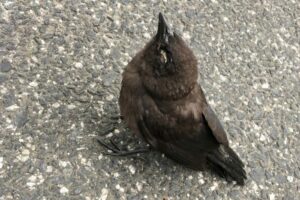Wildlife Alert – Mysterious Bird Deaths
go.ncsu.edu/readext?814508
en Español / em Português
El inglés es el idioma de control de esta página. En la medida en que haya algún conflicto entre la traducción al inglés y la traducción, el inglés prevalece.
Al hacer clic en el enlace de traducción se activa un servicio de traducción gratuito para convertir la página al español. Al igual que con cualquier traducción por Internet, la conversión no es sensible al contexto y puede que no traduzca el texto en su significado original. NC State Extension no garantiza la exactitud del texto traducido. Por favor, tenga en cuenta que algunas aplicaciones y/o servicios pueden no funcionar como se espera cuando se traducen.
Português
Inglês é o idioma de controle desta página. Na medida que haja algum conflito entre o texto original em Inglês e a tradução, o Inglês prevalece.
Ao clicar no link de tradução, um serviço gratuito de tradução será ativado para converter a página para o Português. Como em qualquer tradução pela internet, a conversão não é sensivel ao contexto e pode não ocorrer a tradução para o significado orginal. O serviço de Extensão da Carolina do Norte (NC State Extension) não garante a exatidão do texto traduzido. Por favor, observe que algumas funções ou serviços podem não funcionar como esperado após a tradução.
English
English is the controlling language of this page. To the extent there is any conflict between the English text and the translation, English controls.
Clicking on the translation link activates a free translation service to convert the page to Spanish. As with any Internet translation, the conversion is not context-sensitive and may not translate the text to its original meaning. NC State Extension does not guarantee the accuracy of the translated text. Please note that some applications and/or services may not function as expected when translated.
Collapse ▲According to a Facebook post by the North Carolina Wildlife Resources Commission,
“In late May, biologists began to receive reports of sick and dying songbirds in Washington D.C., Maryland, Virginia, West Virginia, and Kentucky. Infected birds appear to be lethargic and/or have crusty or swollen eyes. More recently additional states have been included, and our agency has begun receiving reports of sick and dying birds which may be due to the new disease.

Infected birds appear to be lethargic and/or have crusty or swollen eyes.
Image from NCWRC Facebook page
To reduce the spread of this outbreak, we recommend:
– Remove bird feeders entirely until the threat subsides. At this time natural food sources are abundant.
– Clean feeders and birdbaths FREQUENTLY with a 10% bleach solution. Rinse with water and allow to dry before refilling.
– Consider native plantings as a healthier, safer alternative to feeders. You can find a list of plants native to your area from the Audubon Society.
– Avoid handling sick or dead birds. If moving a bird is necessary, use gloves or an inverted plastic bag to prevent direct contact with it.
– Keep pets (including pet birds) away from sick or dead wild birds.
If you find dead birds, email hwi@ncwildlife.org with a photo of the dead bird(s), including date found and location. Report sick birds to a licensed rehabilitator.”
As the N.C. Cooperative Extension of Henderson County office gets further information on this emerging issue, we will update this article.




